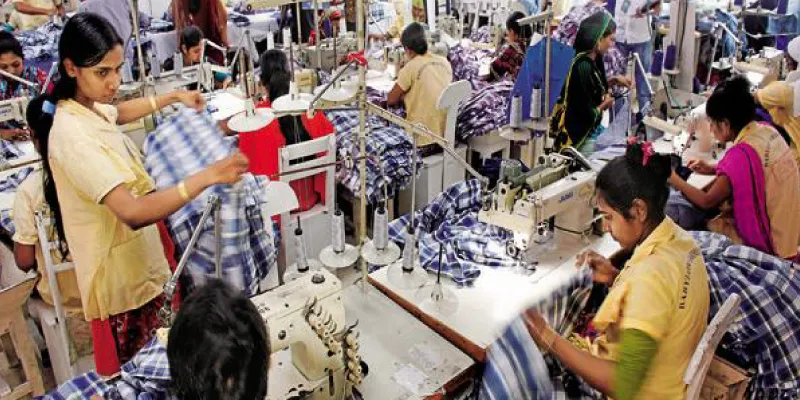1563970530264.jpg)
UNDP India
View Brand PublisherScheme by scheme, how India is transforming into the skill capital of the world
Earlier this month, students from some of the remotest parts of Nagaland got an opportunity to land their first big job with hotels owned by renowned global hospitality brands like Oberoi, Hyatt and ITC. These students were at a job fair held at the Directorate of Employment, Skill Development and Entrepreneurship, Kohima. The event was organised by the Department of Employment, Skill Development and Entrepreneurship under the Pradhan Mantri Kaushal Vikas Yojana (PMKVY), the government’s flagship scheme to provide employable skills to the youth.
Meanwhile, in New Delhi, India’s capital, 1,400 people were placed in jobs during the Skill India Rozgar Mela in March 2019, organised by the National Skill Development Corporation (NSDC).

These are just two out of the thousands of examples of how PMKVY has facilitated the employment of 15.23 lakh people, from the remotest parts of the country to the capitals – in just the last four years. In addition to facilitating employment, the programme has enabled the training and skilling of 72 lakh people across the country in the same period.
Flexing the ‘skilling’ muscle to tap growth
As India marches on towards achieving $1.97 trillion worth GDP growth over the next decade, there is an urgent need to bridge the skill gap that exists in the country today. Corporate India observes that out of the 15 million youngsters entering the workforce each year, 65 percent to 75 percent are not job ready or are unemployable. And, as technology becomes even more pervasive than ever before, and job roles evolve, there is a strong call from the industry for the government to bridge this skill gap. And, it is this need that the Skill India Mission has been addressing since its launch in 2015.
The Mission was developed under the aegis of the Ministry of Skill Development and Entrepreneurship (MSDE) to create convergence across sectors and states in terms of skill training activities and to achieve the vision of ‘Skilled India’
It does this by coming up with regulatory policies, setting up implementing agencies (such as the National Skill Development Corporation India (NSDC) a Public-Private Partnership Company with the primary mandate of catalysing the skills landscape), designing relevant and impactful programmes such as PMKVY and initiating action on ground. In the last half decade, the government has worked consistently to skill and upskill and leverage India’s demographic dividend to drive growth.
From short-term training in areas such as housekeeping, automobile repair, welding, plumbing, front office jobs offered at the 600+ Pradhan Mantri Kaushal Kendras (PMKKs) across 538+ districts in the country, to strengthening the livelihood skills of those living in rural and urban slums through a network of 247 Jan Shikshan Sansthans (JSS), the programmes focuses on the skill requirements of a wide cross-section of society.
Leverages and strengthening the existing ecosystem to further the mission
Collaborations with industry and academia also play a key role to help keep the skilling process relevant and updated. On July 15, World Youth Skills Day, the Skill Development Ministry announced a slew of partnerships with the industry. This included a partnership with India's largest services marketplace, UrbanClap to train 30,000 service professionals and also create micro-entrepreneurship opportunities for candidates certified under PMKVY, partnerships with colleges for degrees in apprenticeship in the media sector, with banks to promote apprenticeship training in the financial sector, among others. In addition, the Ministry also announced the launch of training programmes in new sectors like aerospace engineering and smart agriculture, and academic courses in applied logistics, to enable the youth to tap into the upcoming opportunities in the sector.
One interesting factor that has been instrumental in driving the success of the Mission is that the government has not only put new systems in place but is also optimising the existing infrastructure on ground. A good example would be the Industrial Training Institutes (ITIs). While the ITI ecosystem has been the go-to place for skill training for millions of Indians for decades, their contribution to the skill economy went largely unnoticed. With the launch of the Skill India Mission in 2015, the government brought 12,000 ITIs, spread across the country under the then newly-formed Skill Development and Entrepreneurship Ministry. This move not only enabled the modernisation of ITIs with respect to the curriculum, pedagogy, technology and infrastructure but also has helped to fast-track the adoption of state-run ITIs by corporate India. All this is enabling nearly 14,000 ITIs to play a key role in the Skill India Mission. While PMKKs were set up to fulfil short term skilling training needs in the absence of an existing system, the campaign has leveraged ITIs to offer long-term skilling courses, which has been its innate strength and expertise.
Another good example here is the Scheme for Higher Education Youth in Apprenticeship and Skills (SHREYAS), which the government launched earlier this year. With SHREYAS, the government aims to forge a close functional link between academia and industry on a sustainable basis, and enhance the employability of the Indian youth through ‘on the job work exposure.’ Apprenticeship training is one of the most efficient ways to develop skilled manpower for industry by using training facilities already available in establishments without them having to spend more. A few months into the launch, the government has already lined up a number of industry partnerships. This includes a proposal by SBI to engage 5,000 apprentices as banking front office executive and tele-callers in FY 19-20, and HDFC Bank to hire 10,000 trained professionals under the ‘job-ready’ programme designed and created in association with NSDC, over the next three years. By 2022, SHREYAS is expected to benefit 50 lakh students.
Enabling the workforce to be future ready for a global market
Be it the ITIs, PMKVY, or SHREYAS, they all aim at skilling the workforce to meet the current skill gap in the job market. And, while that is the need of the hour, the government has also adopted a future-looking outlook and is working towards skilling the workforce in future jobs and industry-oriented courses aligned to industry 4.0 such as Artificial Intelligence, 3D Printing, Data Analytics, cyber-security, and automation. Skill India Mission has partnered with industry leaders like SAP, Adobe, IBM to create skill development programs aligned to the needs of Industry 4.0.
That’s not all. Skill India is also working with close to 11 countries across various areas of interest to upscale and ensure global standards in skill development. The government has also signed 19 MoUs with different countries such as UAE, Japan, etc to ensure global mobility through cross-country internship programmes and hiring of Indian workforce for special projects and requirements. In addition, the government is also working with other countries to secure training infrastructure support through international collaboration. For instance, after signing a Memorandum of Cooperation (MoC) with Japan, MSDE has already sent deserving youth for internship training in a leading Japanese automotive company. Nine Japan India Institutes of Manufacturing (JIMs) have also been opened in partnership with Japanese companies under the Manufacturing Skill Transfer Programme. India is also working closely with Singapore Institute of Technical Education to create state-of-the-art India Institute of Skills (IIS) for providing training in specialised skill sets. The first IIS is expected to be launched in Kanpur and followed by Mumbai. The government has also partnered with Emirates Driving Institute (EDI) and Youth Chamber of Commerce (YCC) in April 2019 to set up International Driver Training Institutes (DTIs) in India to promote migration of skilled drivers from India. Similar partnerships have been done with countries like Finland, UK, Australia, France etc. to give a boost to skill development in the country and tap into international opportunities of training and employment.
A special focus on women
While the Skill India Mission focuses on inclusive development, it also aims to increase the participation of women in its various programmes, considering the tangible and intangible value they bring to the work economy. That’s why the programmes under the Skill India Mission have been designed taking their needs into consideration. This includes skilling in areas where women have a stronghold (yoga, beauty and wellness, etc), putting in place guidelines that emphasise creating safe and gender sensitive training environment, complaint redressal mechanism, making provision for safe transport, flexible schedules, childcare support, flexible training delivery mechanisms such mobile training units, among a host of others.

Today, the country has 18 National Skill Training Institutes (for Women) which are imparting skill training exclusively for women. Further, exclusive batches for women have been started under the National Apprenticeship Promotion Scheme in all centrally-funded Institutes. At many PMKKs, crèche facilities are being offered to facilitate the new mothers to take up skill training. In addition to hosting women-centric projects have been such as those targeted at women skilled workers in dairy & poultry farmers, carpet weavers, the government is actively encouraging women to get skilled in non-traditional and new age job roles.
And, the impact on ground speaks volumes for the government’s efforts. Today, close to 50 percent of the candidates enrolled and trained under PMKVY are women, out of the total 56 lakh candidates who have benefited from the scheme 17.72 Lakh have been women. ITIs, have witnessed nearly 97% increase in admissions in 2018 as compared to 2014, an increase from 87,799 to 173,105 women trainees. Under the Recognition of Prior Learning (RPL), more than 4 lakh women candidates have been oriented in different skill areas, recognising their existing skills through a formal certificate and giving them a means to earn better livelihood. In the past two years alone, as many as 892 women have been trained as automation specialists, while about 500 were trained as CNC Operators, areas that hardly saw participation from women earlier. Collaborative efforts with private players to provide training in skill development and creation of occupational opportunities has helped a number of vulnerable and marginalized groups and tribal population. For instance, partnerships with Industree Crafts Foundation is helping train and support 1500 women in Karnataka, and a partnership with Youthnet Home Stay Project in (in Nagaland and Arunachal Pradesh) is improving the quality of homestays and providing a source of income to 200 women.
Keeping the momentum going
The Skill India Mission has played a key role in re-skilling and up-skilling the workforce and helping catalyse growth. First, by ensuring that the skills are learnt through formal means and recognised and certified, is bringing about a shift in the Indian economy – from unorganised to organised. Secondly, the workforce is now better equipped to leverage the existing job opportunities in the country. Third, for employers, this skilled workforce has translated into enhanced productivity. Going by the government-supported studies that estimate an incremental human resource requirement of 103.4 million during 2017-2022 across various sectors, India’s Skill India Mission will need to take forward the good progress it has made in the last four years.







